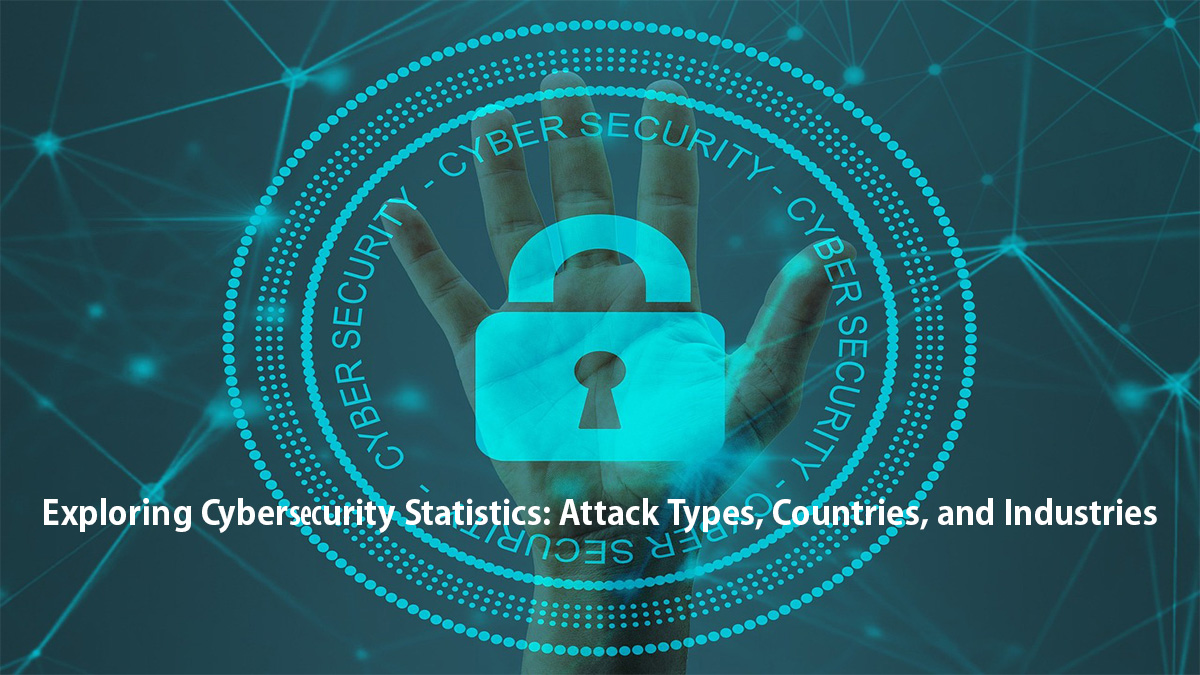Exploring Cybersecurity Statistics: Attack Types, Countries, and Industries

Introduction
In today’s digital age, cybersecurity has become a critical concern for individuals, businesses, and governments alike. With the increasing reliance on technology and the rise of cyber threats, it is essential to understand the landscape of cybersecurity and the statistics that surround it.
This article aims to explore cybersecurity statistics, focusing on different aspects such as attack types, countries affected, and industries targeted. Cybersecurity statistics provide valuable insights into the current state of online security, helping us identify trends, vulnerabilities, and areas that require attention.
By analyzing these statistics, we can gain a better understanding of the threats we face and develop effective strategies to mitigate them. Throughout this article, we will delve into various cybersecurity statistics, shedding light on the different types of cyber attacks, the countries most affected by these attacks, and the industries that are frequently targeted. By examining these statistics, we can gain a comprehensive overview of the cybersecurity landscape and the challenges it presents.
Whether you are an individual concerned about protecting your personal information or a business owner looking to safeguard your organization’s data, understanding cybersecurity statistics is crucial. So, let’s dive into the world of cybersecurity statistics and explore the fascinating insights they offer.
Navigating the Digital Landscape: Protecting Yourself from Cybersecurity Risks
In today’s world, our lives are intertwined with digital platforms. We access financial information online, shop on various retailers’ websites, and share personal details on social media. While these conveniences enhance our daily routines, they also expose us to significant cybersecurity risks.
Understanding the Threats
Malicious hackers are always lurking in the shadows. They exploit security vulnerabilities in software and systems to gain unauthorized access to sensitive information. This can include anything from credit card numbers to personal identification details. As we increasingly rely on digital services, our data becomes a target.
Why You Should Care
The consequences of a cyberattack can be severe. Identity theft, financial loss, and reputational damage are just a few outcomes that individuals and organizations face when their data is compromised. For businesses, a breach can lead to lost customers and legal repercussions.
Protecting Your Personal Data
- Use Strong Passwords: Create complex passwords that combine letters, numbers, and symbols. Avoid using easily guessed information like birthdays or names.
- Enable Two-Factor Authentication: This adds an extra layer of security by requiring a second form of verification before accessing your accounts.
- Be Cautious with Public Wi-Fi: Avoid accessing sensitive information over unsecured networks. If necessary, use a virtual private network (VPN) for added protection.
- Regularly Update Software: Keep your operating system and applications up-to-date to protect against known vulnerabilities.
- Monitor Your Accounts: Regularly check your bank statements and online accounts for any suspicious activity.
Organizational Measures
For businesses, safeguarding customer data is paramount:
- Conduct Regular Security Audits: Identify potential vulnerabilities in your systems.
- Train Employees: Ensure staff understands the importance of cybersecurity practices.
- Implement Robust Security Protocols: Use firewalls, encryption, and secure payment gateways to protect sensitive data.
Conclusion
As we embrace the digital age, awareness of cybersecurity risks is crucial. By taking proactive steps to protect our personal information and advocating for stronger security measures within organizations, we can navigate this landscape safely. Remember: staying informed is your best defense against cyber threats!
The Most Common Kinds of Cybersecurity Attacks
In our digital age, cybersecurity attacks are rampant. They can target anyone—from individuals to large corporations and even government entities. Understanding these attacks is crucial for everyone, especially those entering the cybersecurity field. Here’s a look at some of the most common types of cyberattacks.
1. Phishing Attacks
Phishing is one of the oldest tricks in the book. Attackers send emails that appear legitimate, tricking users into providing sensitive information like passwords or credit card numbers. These emails often contain links to fake websites that mimic real ones.
Tip: Always verify the sender’s email address before clicking any links.
2. Ransomware
Ransomware is a malicious software that locks users out of their systems until a ransom is paid. This type of attack has become increasingly common and can cripple organizations by halting operations.
Tip: Regularly back up your data to minimize damage from potential ransomware attacks.
3. Malware
Malware encompasses various types of harmful software designed to disrupt, damage, or gain unauthorized access to computer systems. This includes viruses, worms, and trojan horses.
Tip: Use reputable antivirus software and keep it updated to protect against malware threats.
4. Denial-of-Service (DoS) Attacks
DoS attacks overwhelm a system with traffic, making it unavailable to users. These attacks can target websites or online services, causing significant downtime and loss of revenue.
Tip: Implement network security measures such as firewalls to help mitigate DoS attacks.
5. Man-in-the-Middle (MitM) Attacks
In MitM attacks, an attacker secretly intercepts communication between two parties without their knowledge. This allows them to steal data or inject malicious content into conversations.
Tip: Always use secure connections (HTTPS) when transmitting sensitive information online.
6. SQL Injection
SQL injection occurs when attackers insert malicious SQL code into input fields on websites or applications. This can allow them to manipulate databases and access sensitive information like user credentials.
Tip: Developers should use prepared statements and parameterized queries to prevent SQL injection vulnerabilities.
7. Credential Stuffing
Credential stuffing involves using stolen username-password pairs from one breach to gain unauthorized access to other accounts on different platforms. Many people reuse passwords across sites, making this attack particularly effective.
Tip: Use unique passwords for each account and enable two-factor authentication whenever possible.
Point
Cybersecurity threats are evolving rapidly, posing risks across all sectors of society. Awareness is your first line of defense against these common types of cyberattacks. As aspiring cybersecurity professionals enter the workforce through bootcamps and degree programs, understanding these threats will be essential in closing the skills gap in this critical field. Stay informed, stay vigilant!
Understanding Cybersecurity Statistics
Cybersecurity statistics provide valuable insights into the current state of cyber threats and the effectiveness of security measures. By analyzing these statistics, businesses and individuals can better understand the risks they face and take appropriate actions to protect themselves.
One important aspect of cybersecurity statistics is the identification of different types of cyber attacks. These statistics help in understanding the tactics used by hackers and the vulnerabilities they exploit. Common types of cyber attacks include malware, phishing, ransomware, and DDoS attacks.
By knowing the prevalence and impact of each attack type, organizations can prioritize their security efforts and implement appropriate countermeasures.
Another key aspect of cybersecurity statistics is the analysis of attacks by country. These statistics reveal the countries that are most targeted by cybercriminals and the level of cyber readiness in different regions.
Understanding the geographical distribution of cyber attacks can help organizations allocate their resources effectively and collaborate with international partners to combat cybercrime. Furthermore, cybersecurity statistics provide insights into the industries that are most vulnerable to cyber attacks. Industries such as finance, healthcare, and government are often prime targets for hackers due to the valuable data they possess.
By examining industry-specific statistics, organizations can identify the areas where they need to strengthen their security measures and invest in specialized cybersecurity solutions.
In conclusion, understanding cybersecurity statistics is crucial for individuals and organizations to stay informed about the evolving threat landscape. By analyzing attack types, countries targeted, and vulnerable industries, proactive measures can be taken to mitigate risks and enhance cybersecurity defenses.
Cybersecurity Statistics by Attack Type
Cybersecurity threats come in various forms, and understanding the different attack types is crucial in developing effective defense strategies. Let’s explore some key statistics related to different attack types.
Malware attacks continue to be a significant concern in the cybersecurity landscape. In 2022 alone, there were a staggering 5.4 billion malware attacks globally. What’s even more alarming is that 4 in 10 malware attacks result in confidential data leakage, posing a severe threat to organizations’ sensitive information.
Ransomware attacks have also been on the rise, with a significant impact on businesses. According to a study, 46% of organizations end up paying the ransom after a ransomware attack. This highlights the financial burden and the difficult choices faced by businesses when dealing with such attacks.
Another prevalent attack type is cryptojacking, which involves unauthorized use of a computer’s resources to mine cryptocurrency. In 2023, there were 1.06 billion cryptojacking attacks, marking a staggering 659% increase compared to the previous year. This indicates the growing popularity of cryptojacking as a means of illicitly obtaining cryptocurrency.
Social engineering attacks, such as phishing and spear phishing, remain a significant threat to individuals and organizations. Approximately 80% of cyber attacks involve weak or stolen passwords, making password-related attacks a common tactic used by cybercriminals.
It is crucial for individuals and organizations to be vigilant and adopt strong password practices to mitigate the risk of falling victim to such attacks.
These statistics highlight the diverse range of attack types that organizations and individuals face in the cybersecurity landscape. It is essential to stay informed about the latest attack trends and invest in robust security measures to protect against these threats.
Cybersecurity Statistics by Country
Cybersecurity threats are a global concern, and different countries face varying levels of risk. Understanding cybersecurity statistics by country can provide valuable insights into the prevalence and impact of cyberattacks.
According to a chart depicting cyber incidents with a political dimension from 2000 to 2023, certain countries have been responsible for the largest share of cyber incidents. These countries include the United States, China, Russia, and North Korea. In terms of the number of cybercrime victims, the United States has been heavily targeted.
In the first half of 2022 alone, an estimated 53.35 million US citizens were affected by cybercrime. Additionally, between July 2020 and June 2021, the US was the most targeted country.
However, it’s important to note that cyberattacks are not limited to these countries alone. Cybercriminals operate globally, targeting organizations and individuals across borders.
The interconnected nature of the internet means that cyber threats can originate from anywhere in the world. To combat cyber threats effectively, countries need to invest in robust cybersecurity measures and collaborate on a global scale. Sharing information and best practices can help strengthen defenses and mitigate the impact of cyberattacks.
As the cybersecurity landscape continues to evolve, it is crucial for countries to stay vigilant and adapt to emerging threats. By analyzing cybersecurity statistics by country, policymakers and security professionals can identify trends, allocate resources effectively, and develop strategies to protect their nations’ digital infrastructure.
Cybersecurity Statistics by Industry
The cybersecurity landscape is constantly evolving, and different industries face unique challenges when it comes to protecting their data and systems. Understanding cybersecurity statistics by industry can provide valuable insights into the vulnerabilities and threats faced by various sectors.
According to a report by IBM, the manufacturing industry is currently the most frequently attacked sector, accounting for 23% of security incursions worldwide. This is not surprising considering the valuable intellectual property and sensitive data that manufacturers possess. The healthcare industry is also a prime target for cyberattacks, with medical records and personal information being highly sought after by hackers. The financial sector is another industry that is heavily targeted by cybercriminals.
Financial institutions hold vast amounts of valuable data, including financial records, credit card information, and customer data. A breach in this sector can have severe financial and reputational consequences.
The retail and e-commerce industry is also a popular target for cyberattacks. With the rise of online shopping and digital transactions, hackers see an opportunity to steal customer data, including credit card information and personal details. A data breach in this industry can lead to significant financial losses and damage to customer trust.
Other industries that are frequently targeted include government and public sector organizations, energy and utilities, and education. Each industry faces its own unique cybersecurity challenges and must implement robust security measures to protect their sensitive data and systems. In conclusion, cybersecurity statistics by industry highlight the importance of implementing strong security measures across various sectors.
Understanding the vulnerabilities and threats faced by different industries can help organizations prioritize their cybersecurity efforts and allocate resources effectively.
Conclusion
In conclusion, cybersecurity statistics provide valuable insights into the current state of cyber threats and vulnerabilities. By understanding the different types of cyber attacks, the countries most affected by these attacks, and the industries that are targeted the most, organizations can better prepare themselves to mitigate risks and protect their sensitive data.
One of the key takeaways from the cybersecurity statistics is the increasing sophistication of cyber attacks. As technology advances, so do the tactics used by cybercriminals. It is crucial for businesses and individuals to stay updated on the latest cybersecurity trends and invest in robust security measures to safeguard their digital assets.
Furthermore, the statistics highlight the global nature of cyber threats. Cyber attacks are not limited to a specific region or country. They can originate from anywhere and target organizations and individuals worldwide. This emphasizes the need for international collaboration and information sharing to combat cybercrime effectively.
Additionally, the cybersecurity statistics shed light on the industries that are most vulnerable to cyber attacks. Sectors such as finance, healthcare, and government are prime targets due to the valuable data they possess.
It is imperative for these industries to prioritize cybersecurity and implement comprehensive security measures to protect sensitive information. In conclusion, cybersecurity statistics serve as a wake-up call for organizations and individuals to take proactive steps in securing their digital infrastructure.
By staying informed about the latest threats and adopting a proactive approach to cybersecurity, we can collectively work towards a safer digital environment.







